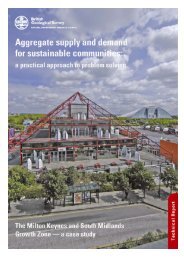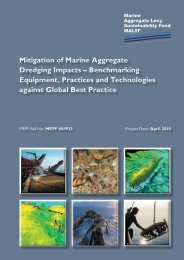creating environmental improvements through biodiversity
creating environmental improvements through biodiversity
creating environmental improvements through biodiversity
You also want an ePaper? Increase the reach of your titles
YUMPU automatically turns print PDFs into web optimized ePapers that Google loves.
The review could be used to inform future studies, and as a source of references and case studies for<br />
developing guidelines on the habitat creation / bird strike issue<br />
Potential Expansion:<br />
The literature review could be updated, as there are likely to be further references and case studies now<br />
available on the topic<br />
Dissemination:<br />
This report was disseminated as part of a larger study by CSL and RSPB (‘Developing policy and best<br />
practice in relation to restoration following minerals extraction – resolving conflicts with aviation’), which<br />
will inform policy and best practice guidance.<br />
DEVELOPING POLICY AND BEST PRACTICE IN RELATION TO<br />
RESTORATION FOLLOWING MINERALS EXTRACTION – RESOLVING<br />
CONFLICTS WITH AVIATION (MIRO, ODPM, DCLG - CSL, RSPB)<br />
A Radar Study of Avian Movement at Cotswold Water Park – RAF Fairford,<br />
Gloucestershire Richard Walls and Mark Brown (Central Science Laboratory)<br />
March 2004<br />
Sustainable Aggregates Creating Environmental Improvements <strong>through</strong> Biodiversity<br />
Project Type: radar bird movement study<br />
Site: Cotswold Water Park and RAF Fairford, Gloucestershire<br />
Project Aim: To better understand the behaviour and spatial extent of bird movements around a wetland<br />
environment during both day and night<br />
Main Methods:<br />
Use of the Central Science Laboratory bird detection radar unit, sited on the airfield of RAF Fairford,<br />
Gloucestershire<br />
Use of two antenna types – one ‘S-band’ in the horizontal plane and one ‘X-band’ in the vertical plane<br />
Recording of all radar target echoes and permanent clutter features around the location, and filtering of<br />
these by bird tracking algorithms within a network of PCs<br />
Scripting of filtered data to a database (continuously around the clock)<br />
Recording of radar parameters for each target echo<br />
Unique identification of targets for tracking in successive scans<br />
GPS referencing of targets to allow future analysis of trends in bird movement with reference to specific<br />
habitat features<br />
Ground truthing by an ornithologist to allow comparison of simultaneous bird identification<br />
Preliminary non-statistical analysis of most obvious movement patterns, concentrating on dawn and dusk<br />
periods<br />
Output:<br />
Shows identity of birds in flight at least to species groups (e.g. gull, duck)<br />
Observes that freezing of some areas of water concentrated waterfowl and gull activity in un-frozen areas<br />
Impacts (Actual):<br />
This was a pioneering piece of work applying radar technology to the study of bird movements, to address<br />
the issue of bird strike. While it may be an expensive approach to use widely, it was effective in this area,<br />
91

















